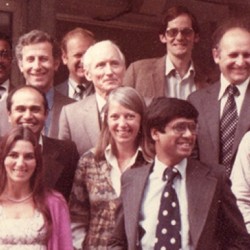By Helen Figueira
November 7, 2011
Time to read: 4 minutes
 CSC symposium honours her career
CSC symposium honours her career
After a career spanning 35 years at the Hammersmith campus, Professor Anne Soutar (Lipoprotein Group Head) retires from her scientific post.
To mark the occasion, colleagues at the MRC Clinical Sciences Centre organized a seminar and reception in her honour on Monday 31st October. The programme featured talks from past scientific collaborators. Professor Geoff Gibbons presented a history of cholesterol, and Professor Steve Humphries discussed the development of our understanding of familial hypercholesterolaemia (FH), while Dr Mafalda Bourbon, an ex-PhD student, described setting up genetic diagnosis of FH in Portugal. Anne finished off with a whistlestop tour of some highlights of her research career exploring the ins and outs of the low-density lipoprotein (LDL)-receptor.
When Anne arrived at the MRC Lipid Metabolism unit in the 1970s, it had been postulated – largely through the pioneering work of American scientist, Ancel Keys – that replacing saturated by unsaturated fat in the diet would reduce blood cholesterol and the incidence of coronary heart disease. What was soon to be discovered, later resulting in a Nobel Prize for Joseph Goldstein and Michael Brown, was that individuals suffering from FH (one in 500 people) had defects in the biological machinery that regulates blood cholesterol.
Family studies revealed that individuals homozygous for the defect suffer severe FH, which while rare (one in a million), results in death by the age of 30. The heterozygous condition is much more common (one in 500 people) though less severe, resulting in early onset of coronary heart disease. Goldstein and Brown linked the high blood cholesterol in these patients to faults in the LDL receptor protein. They identified the function of LDL receptors in the uptake of cholesterol – in the form of low-density lipoprotein (LDL) – from the blood.
Low-density lipoprotein (LDL) is one of the five major groups of lipoproteins that transports cholesterol in the blood. High levels of LDL can cause health problems and cardiovascular disease, so it’s often referred to as ‘bad cholesterol’. Levels of LDL in the bloodstream become elevated if LDL-receptor molecules are in short supply. The receptors, located on cell surfaces, bind LDL and effectively remove it from the blood. In the absence of sufficient receptors, plaques can form in the walls of arteries, eventually leading to heart attack or stroke.
In patients with severe FH, functional LDL-receptors are partially or completely absent. Anne’s research programme involved biological investigations of the disorder by collecting blood samples and cells from families affected by FH. She recounted early attempts to clone the LDL receptor and contrasted the available techniques in the 70s for cloning and sequencing with the extremely powerful methods in use today. She and her team identified a mutation in a homozygous FH patient (Soutar et al 1989), which was later discovered to be prevalent throughout his large extended Pakistani family (Soutar et al 1991), as well as being a recurrent mutation in the UK (Bourbon et al, 1999). Genetic diagnosis of FH, in which her group identified more than 100 different mutations in patients attending the Hammersmith Lipid Clinic (Tosi et al 2007), was to some extent a by-product of her basic research. This focussed on the underlying mechanisms that regulate LDL receptor function and the identification and characterisation of other novel genetic defects that cause FH by affecting the LDL receptor pathway (Eden et al 2002, Herbert et al 2010, Sun et al 2011).
Today almost a thousand such mutations have been identified in the LDL receptor gene of FH patients, which helps to explain why this condition is so common. Understanding the biology of cholesterol and the regulation of its metabolism not only offers new treatments possibilities for FH sufferers, but is also of relevance to the general population in regards to the influence of diet on health. While cholesterol is essential to ‘fluidize’ cell membranes, uptake of excess dietary cholesterol discourages cells to make their own, which impacts on LDL receptor availability and the level of ‘bad cholesterol’ in the blood.
BM